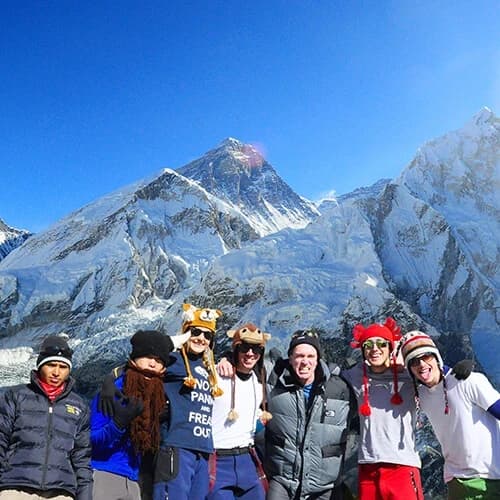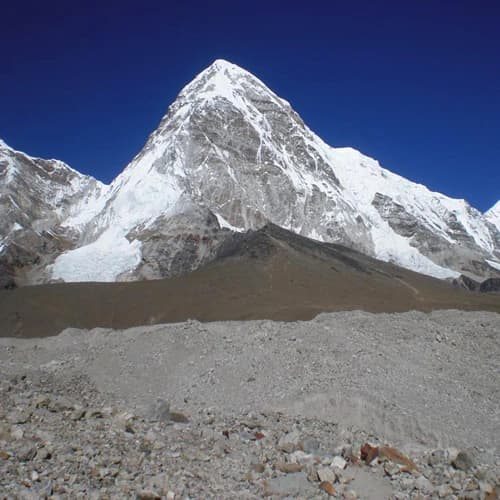Highlights of January Trekking to Everest Base Camp
- Stunning view of Mount Everest
- Crystal-clear skies with the best sunrise and sunset views
- Stunning countryside covered in snow everywhere
- More options for dining and lodging
- Easy access to flights to Lukla
- Vacant trails for enjoyable trekking
- New Year celebration with the local Sherpas
- A heavenly hiking journey for avid trekkers
What's the weather and temperature at Everest Base Camp like in January?
The Everest region is lodged in the higher Himalayas, making it colder than its adjacent counterparts in all seasons. But, the winter season in the Himalayas makes up for the coldest temperature the region encounters in a year. Starting the mid-winter, the area also experiences a higher snowfall rate covering the trails with snow. If you look at your surroundings, almost all the hills and mountains are covered in snow.
Similarly, you might even face harsh winds breezing your way, chilling you down the spine. On the plus side, the sky is cloudless and clear during the daytime, making your journey surprisingly sunny. Carrying warmer apparel is essential to protect yourself from the bitter cold. With snow as far as your eyes can see, the winter trek in the Everest region is a wondrous experience for your lifetime.
The skies will be clean and crisp, and the mountain views will be at their best in January since it hardly ever rains in the Nepalese Himalayas. High altitudes, however, are always susceptible to snowfall. It's best to carry a pair of trekking poles and crampons to walk on heavy snow. In January, the daytime is sunny and surprisingly cozy. Although, you have to be careful about blizzards or strong winds.
In Namche Bazaar, at 3440 m, the average January temperature ranges from 18 to 43°F (-8 to 6°C). The temperature decreases furthermore as you go higher. In January, the Everest Base Camp experiences nightly lows of -5 to -12 degrees Celsius. This is not that bad. To put things in perspective, people stay warm and comfortable in Kathmandu even on the chilliest evenings, reaching 1-2 degrees Celsius. Therefore, you'll feel reasonably warm even at night if you carry warm clothes and sleeping bags. The daytime temperature goes to be around 10 degrees Celsius, which is pretty tolerable.
Why trek to Everest Base Camp in January?
January doesn't offer many compelling reasons to travel to EBC since it is the off-season. But for true adventurers, it's the best month ever. If you're used to the raw nature and want to feel the excitement that only a few dare to, here are a few advantages of a January hike to base camp.
Cloudless Skies and Magnificent Himalayan Panorama
In January, the sky is cloudless most of the time. So, you will be able to bask in the glory of the panoramic Himalayan galore. The Himalayas will follow you throughout the trail. As you ascend higher, they will feel nearer to you. It is one of those feelings that cannot be merely painted with words. To add more, the surrounding mountains of Tengboche are breathtaking and captivating. Numerous places on the EBC route are indescribably beautiful and exhilarating to witness.
Peaceful Trail
January is an off-season trekking month. This means you will have the trail to yourself. You can enjoy your trekking in solitude, making it a wonderful experience. Without having to take into account the crowd, you can simply stroll however you please. You can relish the tranquility and take in the beauty by yourself. You can also use the tea house's perks with fewer people. You may converse with locals and even ask them about particular things you'd like to know.
Easy Getting Flights
Trekking in the off-season has its perks. You need not worry about getting flight tickets to Lukla and back. There is no need to make reservations; tickets are always available. Flights to Lukla are mainly vacant during the off-season, which is impossible during the busy season. If you've visited Lukla during the fall or spring, you would be able to comprehend the anxiety associated with purchasing Lukla tickets. Therefore, buying a flight in January is far less stressful. Additionally, there are lower odds of flight cancellations because of the clear morning skies.
Ample Accommodation Facility
Most teahouses and lodgings will be quieter, with more rooms to spare in winter compared to autumn and spring, when finding your desired hotel in the Everest region is tough. The lodges and teahouses are packed with numerous hikers during the peak trekking season. But you can skip booking early in January and be reassured about getting accommodation. You may also ask for extra blankets since there will be few people, and they will have plenty to share. Likewise, you can get discounts on food and hotels.
January Festivities
Your most spectacular New Year's Eve might involve a trek in the Everest region! Why not plan to visit Namche Bazaar on December 31? It lets you participate in the local celebrations and also see the pubs and nightlife in the higher Himalayas. Isn't it a great way to start a new year?
Likewise, Lhosar is a celebration that occasionally, but not always, takes place in January. For Nepali ethnic groups with ties to Tibet, particularly the Gurung, Tamang, and Sherpa people, this Buddhist festival is a big deal. If you visit during Lhosar, you might witness some celebrations in the Khumbu region. Or, schedule your trip around the Lhosar festival, enriching your cultural experience during your journey.
What are the major concerns about trekking to EBC in January?
It's already a challenging journey to reach Everest Base Camp. Due to the effects of the bitterly cold mid-winter weather, January makes it particularly difficult. Here are a few concerns you may encounter on your January trekking journey to EBC. Take the time to educate yourself on them to tackle them appropriately.
Snowfall and Blockade
You will come across locations with deep snow drifts at higher altitudes. You may, therefore, need to navigate deep snow on your way. The trails can be covered in snow as well. During these moments, be sure to heed your guides' instructions. If not, you risk getting lost and losing your way to your destination. It would also be better to carry a pair of crampons to walk in snowy conditions. Crampons help you anchor yourself on the snow and maintain balance.
Blizzards and Bitter Cold
A blizzard is one of the most formidable obstacles you'll encounter on your January Trek to Everest Base Camp. The region around Mount Everest may experience inclement weather, such as blizzards, due to the chilly wind. It is better to stay updated with weather forecasting for extra safekeeping and stay indoors when the weather is too bad.
Possibility of Frostbite
January brings the bitter cold to the Everest region. You must realize how important it is to get the right hiking equipment. Exercise the habit of layering your clothing. Layers are necessary, especially while you sleep. You must dress in layers because people in Nepal do not practice insulating rooms. You need to prepare yourself correctly to avoid developing frostbite. Avoid exposing your skin as much as possible.
Getting Stuck
In January, it can snow quite a bit, sometimes to the point where mountains of snow are building up every minute. You might need to spend a few days sleeping over in the teahouses if there is too much snow on the ground since it could obstruct your path. Make sure to have some extra days. Himalayan trekking is unpredictable, and this is especially true in the winter. Having additional days on your itinerary is an excellent approach to set yourself up for success.
Solo Trekking
In winter, most of the trails are entirely covered in snow. Therefore, you may get lost if you travel alone. It is an absolute 'No" to trek alone in January when the trails are covered in snow everywhere. Hire an experienced trekking guide who has led groups in the region before and is habituated to the trail.
Is it necessary to hire guides and potters for the January trek to EBC?
Hiring a guide and a porter is a must during a winter trekking journey. A guide is quite helpful when traveling over the Himalayas. They have trekked in the Himalayas for countless years and are experts in the route and the surrounding area. They are similarly chock full of knowledge that will be more useful when hiking. They also understand what to do in an emergency. Having a tour guide with you when you're trekking to Everest Base Camp in January is non-negotiable.
Similarly, porters handle your bulky luggage for you. Your necessities will weigh more in January because of extra clothing, trekking equipment, and other goods. You don't want to be completely worn out while hiking, do you? In order to make your tough January trekking expedition a little more comfortable, hire a guide and a porter.
Tips for the Winter Trekking to Everest Base Camp
- Carry winter trekking equipment like crampons, trekking poles, thick sleeping bags, down jackets, etc. They are much more helpful than you imagine.
- Clothing in layers is essential. Therefore, layer a few thinner woolen clothing so that you can remove them during the day rather than wearing one very thick jacket.
- Check all of your hiking equipment twice. Before beginning your trek, you can purchase any items you might have forgotten in Kathmandu.
- Verify the status of your travel insurance. We suggest you buy rescue and emergency evacuation-covering insurance.
- Keep a few buffer days on hand. You can get caught in the mountains at any time when the weather turns poor. Therefore, a few extra days will prevent the cancellation of your pricey return ticket.
- Drink adequate water, regardless of the cold weather. Try ginger tea, garlic soup, or other beverages instead of plain water for a change.
- Trek with a reputable and trustworthy tour operator. Their experience in the Himalayas will be useful in unfortunate circumstances. They also employ well-trained guides and porters.
Packing List for EBC January Trek
Here is an overall idea of what to bring for an EBC winter trek. Before choosing your final list of items to bring, kindly check with your travel agent.
- Thick sleeping bag
- Hiking socks and worn-in shoes with sturdy soles
- Crampons
- Hiking poles
- Camp shoes (Sneakers and Sandals)
- Down jacket and pants
- Waterproof windcheater jacket
- Waterproof pants
- Trekking T-shirts
- Trekking pants
- Fleece jacket
- Thermal suit
- Extra clothes for layering
- Undergarments
- Woolen caps
- Gloves
- Thick socks
- Backpack and a day pack
- Basic First Aid Kit
- Water bottles
- Guide Book with a Trail map
- Toiletries
- Moisturizer
- Sunscreen Cream
- Sun hat
- Scarf
- UV Sunglasses
- Protein bars
We hope our blog has helped you gain some insights regarding the January trek to Everest Base Camp. It would be best if you did your research as well before embarking on any trekking adventure. We'd be pleased to be of service if you want to reserve the excursion with us. Our team's expertise and two decades of experience in the Himalayas promise you a memorable, safe, and fun trekking trip in the Everest region.
We're here to help you around the clock. Contact us by email at info@outfitternepal.com or Whatsapp at +977 9851137385. We'll see you in Nepal soon.
Some Most Popular Treks




